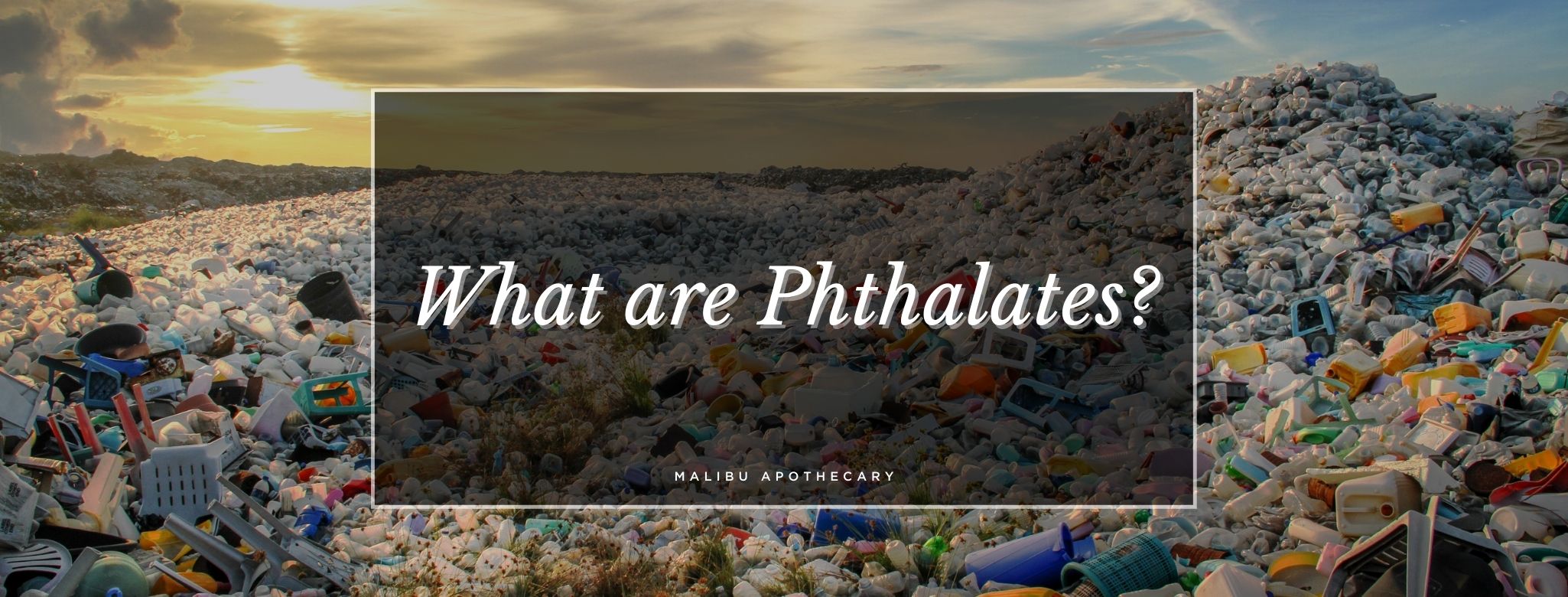You may have heard of Phthalates and their inclusion in our everyday products, but what are they? We will break down what Phthalates are, their purpose, and why they can be harmful to you.
According to the FDA, Phthalates are a group of man-made chemicals or chemical compounds that are commonly used in a variety of products.[1] Often called "plasticizers," Phthalates are used to increase the flexibility in plastics, making them harder to break. They are colorless, odorless, oily liquids that do not evaporate easily and do not chemically bond to the material they are added to.[2] They can also commonly be used as solvents or dissolving agents for other materials and are used as a lubricant in cosmetics as well.
What are Phthalates Found In?
More than 470 million pounds of Phthalates are produced or imported in the United States each year.[3] Phthalates are pervasive in plastics and throughout other common household items or personal care products, “such as toys, vinyl flooring and wall covering, detergents, lubricating oils, food packaging, pharmaceuticals, blood bags and tubing, and personal care products, such as nail polish, hair sprays, aftershave lotions, soaps, shampoos, perfumes and other fragrance preparations.”[4]
By far the most common use of Phthalates is in the production of soft vinyl PVC (polyvinyl chloride). As the second most commonly used plastic in the world, PVC is used in most piping, tubing, construction materials, packaging, electrical wiring, and thousands of consumer goods. Phthalates are not strongly bound in these products and can therefore leach out.[5]
How Are You Exposed to Phthalates?
You can expose yourself to Phthalates through your everyday interactions with products containing this compound and by eating and drinking foods that have been in contact with containers and products containing Phthalates. Although it is to a lesser extent, exposure can occur from breathing in air that contains Phthalate vapors or dust contaminated with Phthalate particles. Once Phthalates enter a person’s body, they are converted into breakdown products (metabolites) that pass out quickly in urine.[6] Environmental Health News reports, Phthalates are so present in our day-to-day lives that 95% of people in the U.S. have Phthalates present in their urine!

How Do I Identify Phthalates in Everyday Products?
Despite its ubiquity, unfortunately, there is no easy way to tell if a product has added Phthalates and products will rarely state “contains phthalates." The first step in knowing how to avoid Phthalates is knowing how to identify them.
There are many different types of Phthalate compounds. The 9 most widely used Phthalate compounds are:
- DBP: di-n-butyl phthalate *used in nail polish to reduce cracking
- DEP: diethyl phthalate *solvent & fixative used in personal care products to enhance fragrance.
- DMP: dimethyl phthalate *used in hair sprays and other styling products to give a flexible hold to hair
- DEHP: di-(2-ethylhexyl) phthalate *added to polyvinyl chloride (PVC) to make products flexible.
- DiNP: di-isononyll phthalate *added as a softener in the manufacture of toys and childcare products, such as bath toys, drinking straws, and rubber ducks
- BBP: butyl benzyl phthalate
- DiDP: di-isodecyl phthalate
- DnHP: di-n-hexyl phthalate
- DnOP: di-n-octyl phthalate
According to the FDA, its 2010 survey of cosmetics indicates that DBP and DMP are used less frequently now, while DEP is still used quite regularly. If provided, try to avoid these signs or labels: phthalate, DEP, DBP, DEHP and “fragrance.” Often, companies can get away with sneaking in Phthalates into fragrances, without being required to report exactly what that means or includes. The FDA states, “regulations do not require the listing of the individual fragrance ingredients; therefore, the consumer will not be able to determine from the ingredient declaration if phthalates are present in a fragrance.”[7]
Are Phthalates Harmful?
Due to the economical and varying uses of Phthalates, they are present throughout most of our daily interactions. So what does this mean for us as consumers and are they harmful to us?
Despite their prevalence, there is actually very few studies that have examined the health effects of Phthalates on humans. Exposure has been studied in lab animals and been found to be associated with numerous reproductive health and developmental problems such as:
- Early onset of puberty
- Interfering with the male reproductive tract development
- Interfering with the natural functioning of the hormone system
- Causing reproductive and genital defects
- Lower testosterone levels in adolescent males.
- Lower sperm count in adult males.
- Phthalates are weak endocrine disruptors and androgen blocking chemicals[8]
Different types of Phthalates have different effects to the human body. Certain Phthalates are known to be endocrine disruptors -- the Endocrine Disruption Exchange (TEDX) includes DEP[9] (*solvent & fixative used in personal care products to enhance fragrance), DEHP[10] (*added to polyvinyl chloride (PVC) to make products flexible), and DBP[11] (*used in nail polish to reduce cracking) as endocrine disruptors. This means that when absorbed into the body, Phthalates can either mimic or block female hormones, or in males, suppress the hormones involved in male sexual development. Phthalates cross the placenta. In addition, over two decades of research suggest that Phthalates disrupt hormones, which can be harmful during critical periods of development -- meaning those most at risk to exposure are children and pregnant women.
How Do Phthalates Impact Varying Income & Racial Groups?
Those who are fortunate enough to purchase products sans Phthalates can do so, but not everyone has the means or know-how. The inequities for those who live below the poverty line are impacted the most. Specifically, the National Center for Health Statistics found for the years of 2011–2014, children living below poverty level had higher median concentrations of all Phthalate metabolites detected in their urine compared with children living at or above poverty level. This also includes the Black community as well, with higher median concentrations of all Phthalate metabolites as compared with all other race/ethnicity groups.[12]
How You Can Avoid Phthalates:
Now you know why you might want to stay away - but how do you do it? Limiting exposure to chemicals or carcinogens can be hard, especially if you don't know if they are even present. Here are a few resources to help curtail your exposure to Phthalates and other chemicals and toxic additives:
- List of substances identified as endocrine disruptors at EU level
- Safe Cosmetics: What’s In My Products
- Environmental Working Group: Skin Deep Cosmetic Database
Buyer Beware!
The impetus is on you as the consumer to do your research and be your own advocate. Check your products' ingredient list, safety labels, and manufacturing guidelines for info on what is in your products. When possible, find plastic alternatives or use BPA-free and/or phthalate-free plastic products. Often, when manufacturers or brands don't tout it, they aren't about it. Increasing customer concern has caused companies to go Phthalate-free and to highlight it on their labels. Look for brands that are clean or non-toxic but make sure to verify this. Often there are many levels to a supply chain, so transparency is critical in knowing what goes into your products and inevitably into your body.
At Malibu Apothecary, we give you one less label to look at as all of our products are Phthalate-free. You can explore our entire clean and non-toxic candle line, which is completely free of phthalates, parabens, paraffin wax, sulfates, and more.
Sources:
Center for Food Safety and Applied Nutrition. “Phthalates.” U.S. Food and Drug Administration, FDA, www.fda.gov/cosmetics/cosmetic-ingredients/phthalates.
“Phthalates Factsheet.” Centers for Disease Control and Prevention, Centers for Disease Control and Prevention, 7 Apr. 2017, www.cdc.gov/biomonitoring/Phthalates_FactSheet.html.
https://www.niehs.nih.gov/research/supported/assets/docs/j_q/phthalates_the_everywhere_chemical_handout_508.pdf
European Commission. List of 146 substances with endocrine disruption classifications prepared in the espert meeting. Available online: http://ec.europa.eu/environment/archives/docum/pdf/bkh_annex_13.pdf October 28, 2020.
The Endocrine Disruption Exchange (TEDX). Diethyl phthalate. Available online: http://endocrinedisruption.org/popup-chemical-details?chemid=527 October 28, 2020.
The Endocrine Disruption Exchange (TEDX). Di(2-ethylhexyl) phthalate. Available online: http://endocrinedisruption.org/popup-chemical-details?chemid=505 October 28, 2020.
The Endocrine Disruption Exchange (TEDX). Dibutyl phthalate. Available online: http://endocrinedisruption.org/popup-chemical-details?chemid=510 October 28, 2020.
[1] https://www.fda.gov/cosmetics/cosmetic-ingredients/phthalates
[2] https://www.niehs.nih.gov/research/supported/assets/docs/j_q/phthalates_the_everywhere_chemical_handout_508.pdf
[3] U.S. Environmental Protection Agency. 2012. Phthalates Action Plan. Washington, DC: U.S. EPA. Available: https://www.epa.gov/sites/production/files/2015-09/documents/phthalates_actionplan_revised_2012-03-14.pdf
[4] https://www.fda.gov/cosmetics/cosmetic-ingredients/phthalates
[5] https://www.epa.gov/sites/production/files/2017-08/documents/phthalates_updates_live_file_508_0.pdf
[6] https://www.cdc.gov/biomonitoring/Phthalates_FactSheet.html
[7] https://www.fda.gov/cosmetics/cosmetic-ingredients/phthalates
[8] https://www.niehs.nih.gov/research/supported/assets/docs/j_q/phthalates_the_everywhere_chemical_handout_508.pdf
[9] The Endocrine Disruption Exchange (TEDX). Diethyl phthalate. Available online: http://endocrinedisruption.org/popup-chemical-details?chemid=527 October 28, 2020.
[10] The Endocrine Disruption Exchange (TEDX). Di(2-ethylhexyl) phthalate. Available online: http://endocrinedisruption.org/popup-chemical-details?chemid=505 October 28, 2020.
[11] The Endocrine Disruption Exchange (TEDX). Dibutyl phthalate. Available online: http://endocrinedisruption.org/popup-chemical-details?chemid=510 October 28, 2020.
[12] https://www.epa.gov/sites/production/files/2017-08/documents/phthalates_updates_live_file_508_0.pdf
Read more

Take us back to Terranea, the rolling hills, and cool sea breeze. Reminiscent of Rancho Palos Verdes and the citrus grove trees that reside in our beloved SoCal, check out this cocktail that will ...

Looking for an easy and creative way to reuse your old candle containers? Give your candle a new home with this fun DIY snow globes! These make great homemade holiday gifts or holiday home decor!

Leave a comment
All comments are moderated before being published.
This site is protected by hCaptcha and the hCaptcha Privacy Policy and Terms of Service apply.